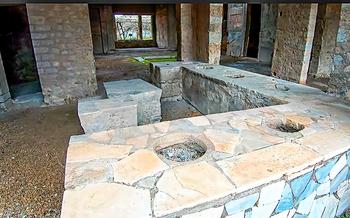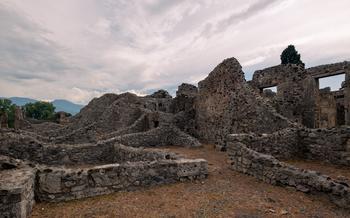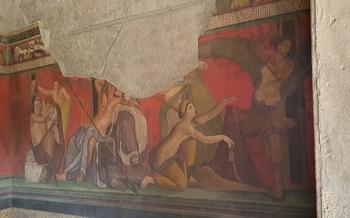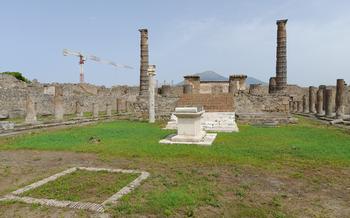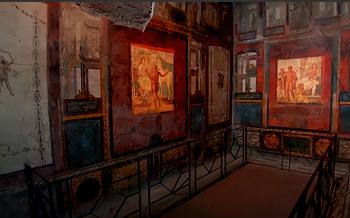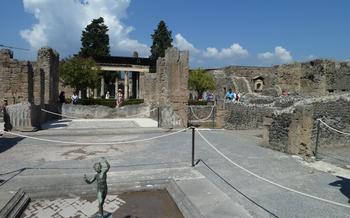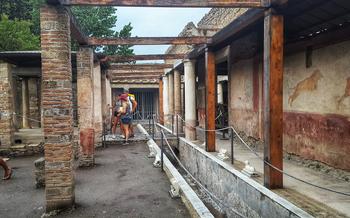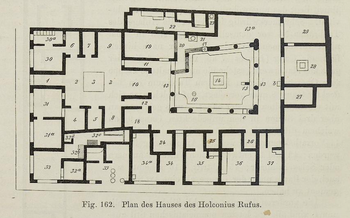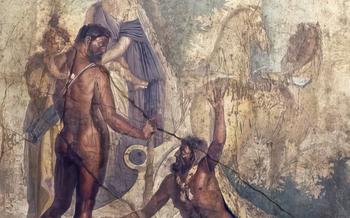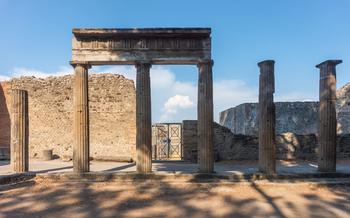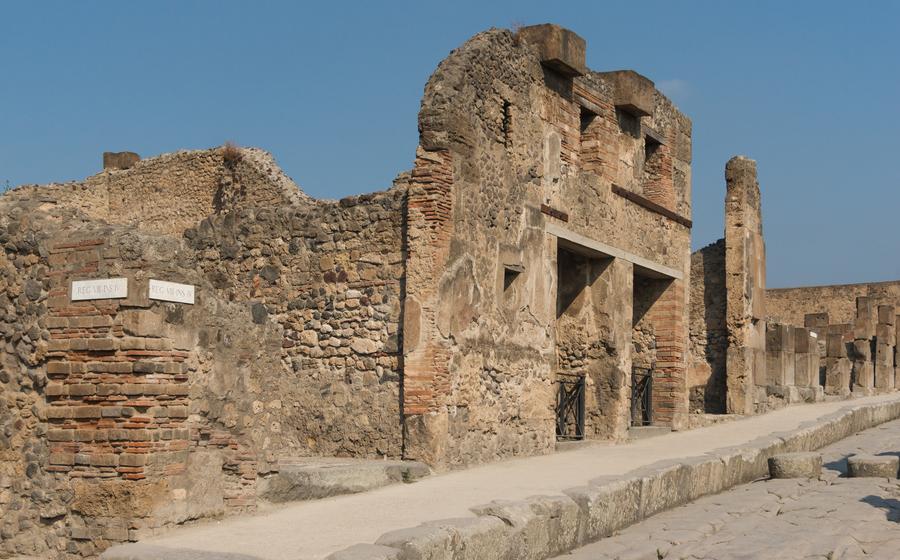
House of Pinarii Cerialis
- Introduction: A Glimpse into Ancient Roman Life
- Location and Accessibility: Finding the House of Pinarii Cerialis
- Opening Hours and Admission: Planning Your Visit
- History and Significance: Uncovering the Past
- Architecture and Design: A Masterpiece of Roman Engineering
- Frescoes and Murals: A Visual Feast
- Mosaics and Floors: Intricate Designs Underfoot
- Household Objects and Artifacts: Glimpsing Daily Life
- Gardens and Landscapes: A Haven of Tranquility
- Virtual Tours and Online Resources: Exploring from Afar
- Guided Tours: Unveiling Hidden Secrets
- Photography and Videography: Capturing Memories
- Accessibility and Facilities: Ensuring a Comfortable Visit
- Insider Tip: Uncovering a Hidden Treasure
Introduction: A Glimpse into Ancient Roman Life
Pompeii, an ancient Roman city immortalized by the catastrophic eruption of Mount Vesuvius in 79 AD, offers a remarkable opportunity to step back in time and explore the remarkably preserved ruins of a once-thriving metropolis. Among the many captivating attractions in Pompeii, the House of Pinarii Cerialis stands out as a must-see destination for travelers seeking an immersive experience into the daily life and culture of the ancient Romans.
The House of Pinarii Cerialis offers a glimpse into the life of one of Pompeii's most prominent families, providing visitors with an intimate understanding of their luxurious lifestyle and the intricate details of their daily routines. With its well-preserved frescoes, stunning mosaics, and opulent furnishings, this grand residence promises an unforgettable journey through history, unveiling the secrets of a civilization frozen in time.
Location and Accessibility: Finding the House of Pinarii Cerialis
Located in the heart of Pompeii's Regio VI, the House of Pinarii Cerialis is easily accessible, whether you're exploring the ancient city on foot, by public transportation, or as part of a guided tour.
Public Transportation: - Take the Circumvesuviana train to the Pompeii Scavi station. - From the station, follow the signs to the Pompeii Archaeological Park. - Once inside the park, follow the map to find the House of Pinarii Cerialis.
Guided Tours: - Many tour operators offer guided tours of Pompeii, including visits to the House of Pinarii Cerialis. - These tours typically depart from Naples, Sorrento, or Rome. - Pre-booking a tour is recommended to secure your spot and avoid disappointment.
Self-Guided Exploration: - Purchase a ticket at the entrance of the Pompeii Archaeological Park. - Follow the map provided to locate the House of Pinarii Cerialis. - Explore the house at your own pace, using a guidebook or audio guide.
Accessibility for Differently-abled Visitors: - The House of Pinarii Cerialis is partially accessible to visitors with wheelchairs. - Ramps and designated parking areas are available. - However, some areas of the house may be difficult or impossible to access due to uneven surfaces and narrow doorways.
Nearby Attractions and Landmarks: - The House of the Vettii: Known for its well-preserved frescoes and mosaics. - The Temple of Apollo: One of the most important temples in ancient Pompeii. - The Forum: The center of public life in Pompeii, where markets, elections, and religious ceremonies took place. - The Amphitheater: One of the oldest and best-preserved Roman amphitheaters in the world.
Opening Hours and Admission: Planning Your Visit
Before embarking on your journey to the House of Pinarii Cerialis, it's essential to plan your visit to ensure a smooth and enjoyable experience. The house is open to the public on all days of the week, except for Wednesdays. Opening hours typically run from 9:00 AM to 7:30 PM during the summer months (April to October) and from 9:00 AM to 5:00 PM during the winter months (November to March).
Admission tickets can be purchased on-site at the entrance of the house. Prices vary depending on the type of ticket and any applicable discounts. Standard admission tickets usually cost around 15 Euros, while discounted tickets for students, seniors, and disabled visitors are often available. It's recommended to check the official website or information boards at the entrance for the most up-to-date pricing and discount information.
To avoid the crowds, it's advisable to visit the house early in the morning or later in the afternoon, especially during peak tourist season. If you're interested in a more personalized experience, consider booking a guided tour. Guided tours are available in various languages and provide insightful commentary and explanations from knowledgeable guides. Advance booking for guided tours is recommended to secure your spot, especially during busy periods.
History and Significance: Uncovering the Past
The House of Pinarii Cerialis, nestled in the heart of ancient Pompeii, holds a wealth of historical significance. Built during the 1st century BC, when Pompeii thrived as a bustling Roman city, this magnificent residence offers a glimpse into the lives of the Pinarii Cerialis family, one of Pompeii's most prominent and influential clans.
The Pinarii Cerialis family played a pivotal role in Pompeii's society, holding high-ranking positions as magistrates and priests. Their political influence and social status are reflected in the grandeur and opulence of their home, demonstrating their wealth and power.
The house showcases remarkable architectural features that exemplify Roman lifestyle and design principles. With its spacious atrium, elegant peristyle garden, and ornate frescoes, the residence embodies the sophistication and luxury that characterized Roman aristocratic living.
By exploring the House of Pinarii Cerialis, visitors gain an intimate perspective into Pompeii's culture and daily life. The preserved artifacts, architectural elements, and stunning artwork provide a tangible connection to the past, allowing us to piece together the lives and experiences of the people who once called this extraordinary city home.
Architecture and Design: A Masterpiece of Roman Engineering
The House of Pinarii Cerialis showcases remarkable architectural features that exemplify Roman ingenuity. Visitors are greeted by an imposing entrance leading to an atrium, the central courtyard of the house. The atrium features a rectangular pool called an impluvium, which collected rainwater for domestic use. Surrounding the atrium are several rooms, including the tablinum, the formal dining room, and the cubicula, the bedrooms.
The house boasts stunning frescoes, mosaics, and sculptures that adorn its walls and floors. The frescoes depict scenes from mythology, history, and everyday life, offering a glimpse into the artistic sensibilities of the Romans. The mosaics, with their intricate designs and vibrant colors, add to the visual appeal of the house.
The House of Pinarii Cerialis also showcases innovative architectural elements, such as the use of arches and vaults. These structural features not only provided support but also created a sense of grandeur and spaciousness. The house's design reflects a harmonious blend of functionality and aesthetics, showcasing the advanced engineering skills of the Romans.
The construction of the house employed various techniques and materials. The walls were made of brick or stone, while the roofs were typically constructed using wooden beams and tiles. The use of concrete, a Roman invention, is evident in the house's foundations and vaults. These construction techniques ensured the durability and resilience of the house, allowing it to withstand the ravages of time and natural disasters.
Frescoes and Murals: A Visual Feast
The House of Pinarii Cerialis is adorned with stunning frescoes and murals that offer a glimpse into the artistic and cultural world of ancient Pompeii. These vibrant paintings, created using a variety of techniques, depict scenes from mythology, history, and everyday life, bringing the walls to life with their intricate details and rich colors.
The frescoes showcase the remarkable skills of Roman artists, who employed various styles and perspectives to create realistic and expressive compositions. From delicate brushstrokes to bold outlines, each fresco tells a story, providing insights into the beliefs, values, and artistic traditions of Pompeii's inhabitants.
One of the most famous frescoes in the house is the "Garden Party," which depicts a group of people enjoying a leisurely gathering in a lush garden. The painting captures the essence of Pompeian lifestyle, with its emphasis on nature, entertainment, and social interactions. Another notable fresco, the "Sacrifice of Iphigenia," portrays a tragic scene from Greek mythology, showcasing the artist's ability to convey emotions and drama through their work.
Through these exquisite frescoes and murals, visitors to the House of Pinarii Cerialis can immerse themselves in the visual culture of ancient Pompeii, gaining a deeper understanding of the artistic expressions and storytelling traditions that prevailed during that era.
Mosaics and Floors: Intricate Designs Underfoot
The House of Pinarii Cerialis boasts stunning mosaics that adorn the floors, adding to the visual splendor of this ancient Roman residence. These intricate artworks showcase the skill and artistry of Roman craftsmen, who meticulously created designs using small, colorful tiles.
The mosaics depict a variety of patterns and motifs, including geometric shapes, floral designs, and scenes from mythology. The central courtyard features a particularly striking mosaic depicting a chariot race, capturing the excitement and energy of this popular Roman sport.
The mosaics not only enhance the aesthetic appeal of the house but also provide valuable insights into Roman culture and beliefs. Many of the designs incorporate symbolic elements, such as animals, plants, and mythological figures, which were believed to bring good luck, prosperity, or protection.
The technique used to create these mosaics is known as opus tessellatum, involving the arrangement of small, square tiles, called tesserae, to form intricate patterns. The tesserae were made from various materials, including marble, limestone, and glass, and were carefully cut and fitted together to achieve the desired design.
The durability of these mosaics is a testament to the skill of Roman artisans. Despite being subjected to centuries of wear and tear, the mosaics have retained their vibrant colors and intricate details, offering a glimpse into the artistry and craftsmanship of the ancient Roman world.
Household Objects and Artifacts: Glimpsing Daily Life
Among the ruins of the House of Pinarii Cerialis lie a treasure trove of household objects and artifacts that offer a fascinating glimpse into the daily lives of Pompeii's residents. These items, frozen in time by the catastrophic eruption of Mount Vesuvius, provide historians with invaluable insights into the domestic routines, habits, and customs of this ancient Roman city.
From the humble kitchen utensils to the elaborate decorative items, each artifact tells a story. Cooking pots, pans, and dishes reveal the culinary practices and dietary habits of the Pinarii Cerialis family and their contemporaries. Amphoras and storage jars hint at the types of food and beverages that were consumed and traded in Pompeii.
Tools and implements used for various crafts and trades offer a glimpse into the economic activities that took place within the household. These include items such as looms for weaving textiles, lamps for lighting, and tools for carpentry and metalworking.
Personal items such as jewelry, cosmetics, and grooming tools provide insights into the daily grooming practices and fashion trends of Pompeii's inhabitants. These artifacts showcase the importance of personal appearance and self-care in Roman culture.
Taken together, the household objects and artifacts discovered in the House of Pinarii Cerialis offer a rich and diverse tapestry of everyday life in ancient Pompeii. They serve as tangible reminders of the humanity and resilience of the people who once called this city home.
Gardens and Landscapes: A Haven of Tranquility
Amidst the bustling streets of ancient Pompeii, the House of Pinarii Cerialis offered its residents a tranquil escape in its beautifully landscaped gardens. These verdant oases were carefully designed to provide a serene and harmonious environment, reflecting the importance of nature and greenery in Roman culture.
The gardens were adorned with a variety of plants and flowers, creating a vibrant tapestry of colors and textures. Fragrant herbs, such as rosemary, lavender, and mint, filled the air with their sweet aromas, while colorful roses, lilies, and poppies added a splash of vibrancy to the landscape.
At the heart of the garden, a sparkling fountain provided a soothing soundtrack, its gentle cascade echoing through the tranquil space. Surrounding the fountain were carefully manicured lawns, inviting visitors to relax and soak in the peaceful ambiance.
Sculptures and statues were strategically placed throughout the garden, adding an artistic touch to the natural surroundings. These works of art depicted mythological figures, deities, and everyday scenes, providing a glimpse into the beliefs and values of Pompeii's inhabitants.
The gardens also featured seating areas, where residents could retreat from the hustle and bustle of city life and indulge in quiet contemplation or leisurely conversations. These secluded nooks were often shaded by pergolas covered in climbing vines, creating a sense of intimacy and privacy.
In the warm summer months, the gardens offered a welcome respite from the scorching sun. The lush foliage provided shade and coolness, while the gentle breeze carried the scent of jasmine and honeysuckle through the air.
Overall, the gardens of the House of Pinarii Cerialis served as a sanctuary for its residents, a place to escape the demands of daily life and find peace and tranquility amidst the beauty of nature.
Virtual Tours and Online Resources: Exploring from Afar
Whether you're unable to travel to Pompeii in person or simply want to enhance your visit with additional insights, there are numerous virtual tours and online resources available to bring the House of Pinarii Cerialis to you. These virtual experiences offer a unique opportunity to explore the house's stunning frescoes, intricate mosaics, and fascinating artifacts from the comfort of your own home.
Some reputable websites and platforms that offer virtual tours of the House of Pinarii Cerialis include:
- The Pompeii Archaeological Park website: This official website provides a comprehensive virtual tour of the entire archaeological site, including the House of Pinarii Cerialis.
- Google Arts & Culture: Explore the House of Pinarii Cerialis in stunning detail through Google's Street View technology and high-resolution images.
- Virtual Tour Rome: This website offers a guided virtual tour of the House of Pinarii Cerialis, narrated by an expert guide.
To make the most of your virtual tour, consider using headphones to fully immerse yourself in the audio commentary and sound effects. Take your time to zoom in on the details of the frescoes and mosaics, and use the interactive features to learn more about the history and significance of each room.
By combining virtual tours with online resources, you can gain a deeper understanding of the House of Pinarii Cerialis and its place in ancient Roman history, even if you're unable to visit in person.
Guided Tours: Unveiling Hidden Secrets
Enrich your visit to the House of Pinarii Cerialis by joining a guided tour. Led by knowledgeable local guides or historians, these tours offer an immersive experience that brings the ancient ruins to life. Guides provide fascinating insights into the history, architecture, and significance of the house, shedding light on the lives of its occupants and the broader context of Pompeii's society.
Various tour options are available to suit different interests and budgets. Group tours offer a social and interactive experience, allowing you to learn alongside fellow travelers. Private tours provide a more personalized experience, with the guide's undivided attention and the flexibility to tailor the tour to your specific interests. Themed tours, such as those focusing on art, history, or daily life, delve deeper into specific aspects of the house and its inhabitants.
Choose a guided tour that aligns with your interests and budget to make the most of your visit. Whether you opt for a comprehensive overview or a specialized tour, you'll gain valuable insights and a deeper understanding of this remarkable Roman dwelling.
Photography and Videography: Capturing Memories
Photography and videography are permitted within the House of Pinarii Cerialis, allowing visitors to capture lasting memories of their visit. However, it's essential to follow the established guidelines and restrictions to ensure the preservation of this ancient site. Flash photography is prohibited, as it can damage the delicate frescoes and artifacts. Tripods and selfie sticks are also not allowed, as they can obstruct the paths and disturb other visitors.
To capture stunning images, consider using a wide-angle lens to capture the grandeur of the house's architecture and frescoes. Experiment with different angles and perspectives to showcase the unique features of each room and courtyard. For close-ups of the intricate mosaics and sculptures, use a macro lens to reveal the fine details and craftsmanship.
When recording videos, maintain a steady hand or use a tripod to avoid shaky footage. Consider narrating your video to provide insights and context about the history and significance of the House of Pinarii Cerialis. Remember to respect the privacy of other visitors and avoid filming them without their consent.
By adhering to these guidelines, you can capture beautiful memories of your visit to the House of Pinarii Cerialis while preserving this ancient treasure for future generations.
Accessibility and Facilities: Ensuring a Comfortable Visit
The House of Pinarii Cerialis is committed to ensuring that all visitors have a comfortable and enjoyable experience, regardless of their abilities. The site is wheelchair accessible, with ramps and designated parking areas available for visitors with disabilities. Restrooms, drinking fountains, and seating areas are also located throughout the site for visitors' convenience.
For those seeking additional support, guided tours with sign language interpretation or audio description can be arranged upon request. Visitors can inquire about these services at the ticket office or through the Pompeii website.
In addition, the site offers a range of amenities to enhance visitors' experience. A gift shop is available for those wishing to purchase souvenirs or learn more about the history of Pompeii and the House of Pinarii Cerialis. A café is also located on-site, providing a place for visitors to relax and enjoy refreshments.
To ensure a seamless visit, visitors are advised to wear comfortable shoes suitable for walking on uneven surfaces. Sunscreen, hats, and sunglasses are also recommended for protection against the sun's rays. Visitors are also encouraged to bring water bottles to stay hydrated, as there are limited drinking water fountains available on-site.
By providing these facilities and services, the House of Pinarii Cerialis aims to create an inclusive environment where all visitors can explore and appreciate the wonders of this ancient Roman home.
Insider Tip: Uncovering a Hidden Treasure
While exploring the House of Pinarii Cerialis, don't miss the opportunity to discover a hidden gem often overlooked by visitors – the small, intimate garden nestled behind the peristyle. This secluded paradise, surrounded by lush greenery and fragrant flowers, offers a tranquil retreat from the bustling crowds. Adorned with a delicate fountain and intricate mosaics depicting scenes from mythology, this hidden gem invites you to pause and soak in the serenity of ancient Pompeii. Take a moment to sit on one of the stone benches, let the gentle breeze caress your face, and imagine yourself as a Roman aristocrat enjoying the tranquility of this private oasis.
